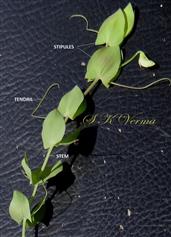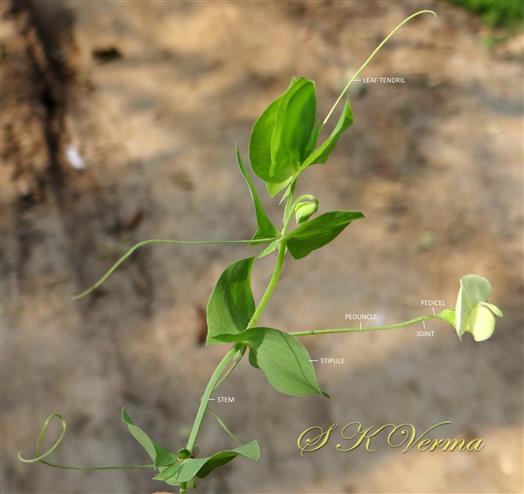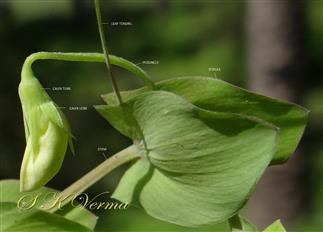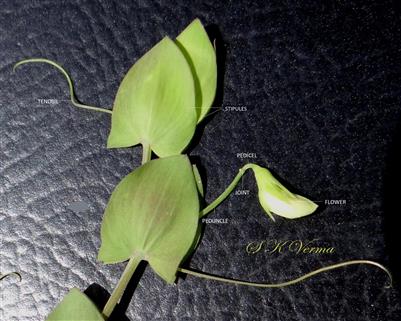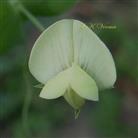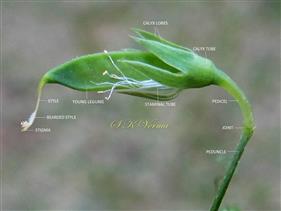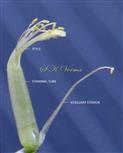LATHYRUS
Lathyrus
L., Sp. Pl. 729. 1753; Gen. Pl. ed. 5. 326. 1754; Baker in Hook. f., Fl. Brit. Ind. 2: 179. 1879; Ali, Biologia 11(2): 1. 1965; Collett, Fl. Siml. ed. 2: 135. 1921 (Reprint 1980); Fl. Pak. @ eFloras.org p. 275; Bao & Kenicer, Fl. China @ eFloras.org 10: 572.
Annual or perennial herb; stem weak, sometimes climbing, usually angular, sometimes winged. Leaflets 2-8, sometimes none as in L.aphaca, entire; rachis ending in a long tendril or in a short bristle. Stipules large, acute, usually produced below the attachment in 2 long, pointed lobes, sometimes foliaceous. Flowers bisexual, zygomorphic, 5-merous, perigynous, +/- axillary, stalked, solitary or in pairs or in pedunculate racemes. Calyx campanulate; teeth 5, nearly equal or the 3 lower longer. Petals longer than calyx; purple, pink, yellow or white or rarely red orange; vexillum erect, broad with a short claw and notched; keel nearly straight, obtuse, shorter than wings; wings free or coherent with keel. Stamens 10, diadelphous (9+1); vexillary stamen free; filaments filiform or distally dilated; anthers uniform Monocarpellary, ovary subsessile or stipitate, unilocular with few-many ovules, placentation marginal; style incurved, linear or flattened below the stigma, bearded along the inner face; stigma small. Legume oblong, flat, laterally compressed, tipped with a persistent style. Seeds 2- many.
181 species
Lathyrus aphaca
Lathyrus aphaca
L., Sp. Pl. 279.1753; Baker in Hook. f., Fl. Brit. Ind. 2: 179. 1879; Ali, Biologia 11(2): 2. 1965; Collett, Fl. Siml. ed. 2: 135. 1921 (Reprint 1980); Sharma & Kachroo, Fl. Jammu (Illustr.) 2: t. 79. 1983; Dhaliwal & Sharma, Fl. Kullu Dist. 228. 1999; Kaur & Sharma, Fl. Sirmaur 258. 2004; Singh & Sharma, Fl. Chamba Dist. 278. 2006; Fl. Pak. @ eFloras.org p. 276; Pisum aphaca (L.) Brot., Fl. Lusit. 2: 145. 1804.
Annual, stem trailing, up to 75 cm long, not winged, glabrous. Leaves completely modified into unbranched 1.5-8 cm long tendril. Leaflets none. Stipules foliaceous broadly ovate, hastate, ca. 2.5 cm x 1.2 cm, entire, acute to acuminate; veins radiating from base, glabrous. Flowers bisexual, zygomorphic, 5-merous, perigynous, pale yellow, ca. 1 cm long, solitary, rarely two, at the end of long axillary peduncle, ca. 3 cm long, pubescent; pedicel articulated with peduncle. Calyx 6-9 mm long, tube short, teeth ca. 2-3 times longer than tube, lanceolate, acute. Corolla 5, papilionaceous, pale yellow; vexillum ca. 10 mm x 10 mm, pale yellow with purple streaks, suborbicular-ovate, base narrow, 2 oblique ridges near base; wings nearly equal to vexillum, ca. 9 mm long, inflexed, auriculate; keel shorter than wings, straight, obtuse. Stamens 10, diadelphous (9+1), vexillary stamen free, nine fused to form ca. 5 mm long staminal sheath; anthers uniform, ca. 0.3 mm long, basifixed. Ovary ca. 5 mm long, sessile, slightly pubescent, unilocular, 4-6-ovuled, placentation marginal; style 4 mm long, incurved, flattened below the stigma, bearded along the inner face; stigma small. Legumes 2.5-3.2 cm x 0.5-0.7 cm, oblong, flat, tipped with persistent style; 4-6 seeded.
Common Names: Wild Pea, Yellow Pea; Yellow Vetch; Yellow Vetchling; Jangli Mattar (Hindi)
